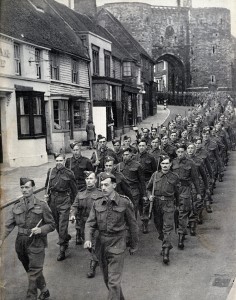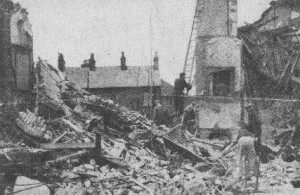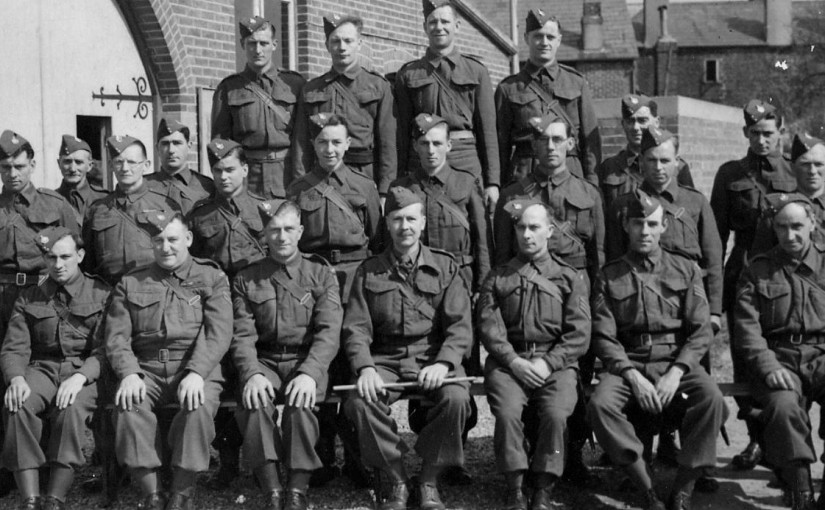War Comes to Rye
Rye went to war on 3 September 1939 – As war was declared a German Coaster was still tied up at The Strand. The German family who crewed her were well known and liked in Rye, They had been bringing in timber from the Baltic and taking scrap metal to Germany. The Harbour Master let them slip out of the Rother and take their chances on getting home. The sailed of into the English Channel flying the German National flag and a Swastika.
Then came the ‘Phony War’. The British Expeditionary Force were ashore in France but were not called to action for months. Then, on 10 May 1940, Germany attacked France and the neutral Low Countries. Luxembourg was occupied on day one and the Netherlands surrendered on May 14, followed by Belgium on May 28, by which time, the B.E.F., which had raced through Belgium to meet the Germans, had been out gunned and out manoeuvred and pushed back to the beaches of Dunkirk. From 27 May to 4 June, great numbers of troops, British and French, were plucked off the beaches by the Royal Navy, helped by a fleet of small boats from the Kent and Sussex coast. Pleasure Boats, Fishing Boats, Lifeboats, even a Paddle Steamer, proved Britain still was a Nation of seamen. The ‘Miracle of Dunkirk’ brought more than 338,000 men off the besieged beaches and enabled a new army to be built, even though all of its transport and artillery pieces had to be left behind.
Now the German Army was only 22 miles from Dover and Rye would be a prime target for a Nazi invasion, which was surely only days or weeks away.
In Rye a Volunteer Reserve, soon to be called the Home Guard, was formed.
A PICTURE THAT PAINTS A 1000 WORDS – RYE HOME GUARD
The picture on that captures more than a thousand words could say. It was

taken in the dark days of 1940 when Hitler’s hoards were expected to invade this corner of England at any moment.
A Local Defence Volunteer force, the L.D.F as it was called, was formed in every town and village in the land. It was made up of young men not yet old enough to join the regular forces, men unable to join up because of reserved Wades or invalidity exceptions and men too old to join, many in this category had fought in the First War. They were a formidable group even though at first they were armed mainly with pick handles and shot guns.

Soon the L.D.F. became the Home Guard and in the course of time was properly armed and no doubt would have given a good account of itself if the R.A.F. had not thwarted Hitler’s plans.
THE BATTLE OF BRITAIN
During August and September of 1940 Ryers had a grandstand seat for the greatest air battle in history, The Battle of Britain raged in the skies over the town and Ryers watched from Hilder’s Cliff as wave after wave of German Aircraft passed overhead. They watched the attack on the Home Chain Radar installation at Kent Ditch Corner, locally known as The Pylons, which were the ‘Eyes’ of the R.A.F. Although several personnel were killed in the raid, R.A.F. Rye was soon back in operation. On Sunday 18th. August seven German Bombers returning towards the coast after being turned back by Spitfires and failing to release their bombs on London, decided that Rye would be a softer option and delivered their payload in the Cadborough Cliff area. Fortunately most of the bombs failed to explode and were disposed of by the men of the Bomb Disposal Squad. One disarmed 50 Kilo bomb was left with Tom Upton whose cellar it had entered. He fitted it with a coin slot and used it to collect money for the Spitfire Fund.
Rye’s first fatalities occurred on 18 August when Godfrey Row was bombed

By October the German tactics had changed, they suffered great losses in their daylight raids on London. From the beginning of October night raids only were made on the Capitol but daylight ‘Tip and Run’ raids were carried out on coastal towns. Rye had another dose of daylight bombing on the 9th. when eighteen 50 kilo bombs were dropped doing extensive damage.
1941 RYE IN THE FRONT LINE
Mr. Wimpenny had come to Rye from Lowestoft in 1940 to take up the office of Area Fisheries Officer. He evacuated his wife Helen and two children, Julian and Elizabeth to Ambleside in the Lake District and made his home at number 2 Pound Cottages, Udimore where he resided with the family dog ‘Jimmy’.
Working from an office adjacent to Phipps and Co the accountants in Landgate, with a staff of two, a Mr. Service and Miss Flagg, he decided that as they were living through such eventful times he would record his own personal diary for the complete year of 1941. This document gives an insight to the life and people of Rye and the business like fashion in which they conducted their affairs during a period when invasion by Hitler’s Armies seemed imminent and Romney Marsh was considered as the most likely landing and assembly point for any such attack.
On January 1St. 1941 Mr. Wimpenny, a very methodical and reliable man, journeyed to Rye on the regular Maidstone and District Bus with his dog, taking up his usual seat next to ‘chess mate’ Mr. Wood (later to become Rye Borough Surveyor). He and his staff spent the day working on a weekly report and analysis of the individual catch records of fishing vessels from October. He lunched at The Monastery Guest House. Two courses and Coffee for one shilling and nine pence (8p.) He obtained a Dog Licence for 7/6 at the Post Office (then in the High Street). He mentioned seeing a thin new moon over the Landgate. He made one other purchase, a packet of cigarettes 6d. before catching the 6.15 bus home to Udimore.
Throughout a cold January, a real Winter with deep snow and frozen pipes and a month when, almost nightly the roar of German Bombers was heard as squadron after squadron of Dorniers and Heinkels passed overhead on their way to bomb London, Wimpenny’s path is crossed by many Rye characters. Mr. Cat, grave digger to the Burial Board, Dr. Hartley, The Thorpe Brothers, corn merchants, Mr. Finch, chief engineer at the Catchment Board, Mr Bellhouse who had the Garage at Monk Bretton Bridge and also owned the Rye fishing smack the Dorothy Margaret, Mr. Phipps accountant, Mr. Stocks, manager of the local Food Office and Mr. Rogers of ‘Wilkins of Rye’ the caterers.
February was quite an eventful month for Mr. Wimpenny. He purchased a yacht, the ‘Sally’ and obtained permission from the wartime local navel commander, Admiral Willis and the Harbour Master Jack Doust to move the vessel from Rye Harbour to a berth hard by Phillips’ Boat Yard in the Rock Channel. He obtained a large tarpaulin sheet from Mr. Varley at Sea Cruisers to protect his purchase from the elements.
He listened avidly to Churchill’s speeches on the Radio and commented that even though Winston mentioned the possibility of imminent invasion he seemed pretty confident that any such enterprise by the Germans would fail. Looking across at the Kings Head he saw Jack Cooke the Farmer in his Home Guard uniform “on watch on this lovely moonlight evening.”
Wimpenny records so many events in his diary of 1941, his fondness of country life, he kept Bees and Chicken. The terrible day when his dog was knocked down by a Canadian soldier in an army truck and had to be destroyed. The dismay and shock on the sinking of H.M.S. Hood and the elation felt when The Bismark was sunk. The realisation that Hitler had invaded Russia and would not be coming here. The joy when his wife and children were able to return and be with him again.
He also recorded the unfolding events in the fishing industry of Rye and South East Coast ports, the Rye Boats and their Skippers. The wartime eating places of Rye, Webbs, Longs, Monastery Guest House, Dormy House, The Copper Kettle, Wilkins etc.
His great friendship with Mr. Wood and his family at the Hundred House and their many games of chess, which were almost invariably won by the Rye Council official. His favourite among the three Wood children was Anne. Only a baby at that time but later destined to become the youngest Mayoress of Rye as companion to Maurice Beavers.
The final entry tells of the fulfilled New Year’s resolution in the completion of the Diary, the relief that 1942 would be unfettered with such a task and the regret that “It might have been better to have kept a record in 1940 with its epic Battle of Britain, so much of which I witnessed, the Dunkirk Evacuation and the Night Bombings.”
On 16th. September 1942 Rye was bombed, one bomb exploding at the end of Watchbell Street near the Steps causing some fatalities and a lot of damage.
Regent Cinema Destroyed
Six days later came another air raid. This time destroying the Regent Cinema in Cinque Ports Street. Houses in South Undercliff were also hit. Mrs Carey with her small baby were pulled from the wreckage they had taken shelter in the foyer. The only fatality at the Cinema was the relief Manager from London who was to be in Rye for just a fortnight to get a respite from the London Bombing.
On November 15th. Church Bells were heard in Rye for the first time since the invasion scare of 1940. The bells were ringing to acclaim the victory of Allied troops in Africa.
1943 saw one heavy raid on the Town when a mixed bag of bombs were dropped doing considerable damage. Rye was very lucky throughout this period, mainly because there were no large industrial plants in the vicinity.
HITLER’S SECRET WEAPON
Early June 1944 was an optimistic period for the people of Rye and Britain. Here on the Southern Coast great Armies were massing in preparation for the invasion of Hitler’s Europe.
The German forces were already hard pressed by the Russian Armies smashing their way towards Germany from the East. The Luftwaffe, it seemed, was defeated. The Royal Air Force had maintained mastery of the air and few German raids were being launched against the South Coast. Almost everyone evacuated during the crisis times of 1940 had drifted home. “Hitler’s days are numbered” people were saying, “It will all be over by Christmas.”
The great invasion began on the 6th. June and after heavy fighting on the Normandy beaches the Allied Armies gained a strong foothold and began to build up reserves and supplies in preparation for the great thrust across occupied Europe. In Rye many families waited anxiously for news of their loved ones, fighting again on French soil.
AEROPLANES WITH REAR LIGHTS
Exactly a week after D-Day, on 13 June, Rye Fire Watchers noticed a strange aircraft with a bright red rear light crossing the Town from the sea and making its way inland. What could it be? Talk of Hitler’s secret weapons had been going on for many months and threats by Lord Haw Haw on German propaganda broadcasts to Britain had hinted that these weapons were soon to be unleashed. The Aeroplanes with Rear Lights turned out to be V1’s Flying Bombs. The V1’s , soon to become known as Doodle Bugs’ came in ever increasing numbers, from a few a day at the outset they were shortly crossing the coast in their hundreds.
SECOND EVACUATION
For a second time many women and children were evacuated from Rye. At first the problem seemed hopeless, the Flying Bombs were propelled by a pulse jet and were faster than our fighter aircraft and were very difficult to shoot down. R.A.F. Fighter Pilots evolved a method of tackling these pilot-less menaces, by diving from above they were able to accumulate enough speed to catch and dispatch them by tipping up their wings. They were unable to shoot at them from close range because if the bomb exploded it would knock the attacking aircraft out of the air.
A.A. GUNS AT CAMBER
Hundreds of guns were brought South and the biggest concentration of artillery in the country was massed between Camber and Rye Harbour. There were 1,300 gunners on those sites and the cannonade was terrific.
These anti Flying Bomb precautions prevented a large number of the V1’s. from reaching their targets. They were usually aimed at London. Shooting them down as they crossed the coast brought great danger to Rye and the surrounding area. Six Flying Bombs came down in the Borough and Civil Defence Personnel were reinforced to deal with casualties caused by these destructive weapons.
CURTAIN OF STEEL
At the height of the Flying Bomb period the barrage from the artillery was a fantastic sight at night. Looking from Rye towards the sea the whole coast line was lit by the bursting shells and the stabbing fingers of light projected by search lights. Dozens of Doodlebugs failed to get through the curtain of steel and crashed harmlessly into the sea and on the marshland around Rye. Much damage was caused however by the bombs that dropped in populated areas.
With the successful offensive in France the bomb dispatch sites were moved back as the Allied front advanced and gradually the number of Flying Bombs were reduced.
THE BOMB THEY COULD NOT STOP
The War was not over by Christmas 1944, it stretched on into 1945 and before the final victory over Germany a new and even more sinister weapon was used by Hitler, the V2. The V2 was a rocket bomb against which there was no defence. These bombs always reached their target, London and its suburbs and as none were stopped en route, Rye did not have to contend with this weapon.
